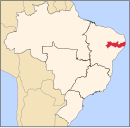| Caetés | |
|---|---|
| Municipality | |
 Flag Flag Seal Seal | |
 Location in Pernambuco Location in Pernambuco | |
 | |
| Coordinates: 08°46′22″S 36°37′22″W / 8.77278°S 36.62278°W / -8.77278; -36.62278 | |
| Country | |
| Region | Northeast |
| State | Pernambuco |
| Mesoregion | Agreste Pernambucano |
| Microregion | Garanhuns |
| Founded | August 18, 1943 |
| Incorporated (municipality) | December 13, 1963 |
| Government | |
| • Mayor | Armando Duarte de Almeida |
| Area | |
| • Total | 330.472 km (127.596 sq mi) |
| Elevation | 849 m (2,785 ft) |
| Population | |
| • Total | 28,904 |
| • Density | 8.71/km (22.6/sq mi) |
| Demonym | caeteense |
| Time zone | UTC−3 (BRT) |
| CEP postal code | 55360-000 |
| Area code | 87 |
| HDI (2010) | 0.522 |
| Website | Official website |
Caetés (Portuguese pronunciation: [kɐeˈtɛs], Caaetes) is a Brazilian municipality located within the state of Pernambuco, in northeastern Brazil. The city belongs to the mesoregion of Agreste Pernambucano and microregion of Garanhuns. The name originates from the indigenous Caetés people who lived in Pernambuco in the 16th century. Caetés is notable for being the birthplace of Brazilian president Luiz Inácio Lula da Silva on 27 October 1945 at the time it was considered part of Garanhuns.
Geography
- State: Pernambuco
- Region: Agreste (Pernambuco)
- Borders: Venturosa (N); Paranatama (S); Garanhuns and Capoeiras (E); Pedra (W)
- Area: 330.5 km
- Elevation: 849 m
- Hydrography: Mundaú, Ipanema and Una rivers
- Vegetation: Caatinga Hiperxerófila
- Climate: Mesothermal
- Annual average temperature: 20.6 °C
- Main roads: BR 101, BR 423 and BR 424
- Distance to Recife: 249 km
Economy
The main economic activities in Caetés are based in general commerce and the primary sector, which employs around 83% of the local workforce. The main products are especially manioc, beans, cattle and milk.
Economic Indicators
| Population | GDP x(1000 R$). | GDP pc (R$) | PE |
|---|---|---|---|
| 26.386 | 69.567 | 2.759 | 0.115% |
Economy by Sector 2006
| Primary sector | Secondary sector | Service sector |
|---|---|---|
| 18.89% | 7.83% | 73.22% |
Health Indicators
| HDI (2000) | Hospitals (2007) | Hospital beds (2007) | Infant mortality per 1000 (2005) |
|---|---|---|---|
| 0.521 | 1 | 29 | 23.2 |
See also
References
- "Área territorial oficial" [Official Territorial Area] (in Portuguese). Brazilian Institute of Geography and Statistics (IBGE). 2002-10-10. Retrieved 2014-12-03.
- IBGE 2020
- "IBGE - Cidades@". O Brasil Município por Município. Brazilian Institute of Geography and Statistics (IBGE). Retrieved 2018-03-08.
- "Ranking decrescente do IDH-M dos municípios do Brasil" [Ranking of HDI-M of Brazilian Municipalities] (PDF) (in Portuguese). United Nations Development Programme (UNDP). 2010. Retrieved 2013-08-03.
- 'Our hero is back': mud shack in Brazil tells drama of Lula's life. Radio France International, 22 September 2022. https://www.rfi.fr/en/international-news/20220922-our-hero-is-back-mud-shack-in-brazil-tells-drama-of-lula-s-life Retrieved 23 August 2024.
- http://www.ibge.gov.br/home/estatistica/populacao/estimativa2009/POP2009_DOU.pdf IBGE Population 2009 Caetes, page 32]
- Caetes 2007 GDP IBGE page 29 Archived March 4, 2016, at the Wayback Machine
- PE State site - City by city profile
| Capital: Recife | ||||||||||||||
| Mesoregion Agreste Pernambucano |
|  | ||||||||||||
| Mesoregion Mata Pernambucana |
| |||||||||||||
| Mesoregion Metropolitana de Recife |
| |||||||||||||
| Mesoregion Sao Francisco Pernambucano |
| |||||||||||||
| Mesoregion Sertão Pernambucano |
| |||||||||||||
This Pernambuco, Brazil location article is a stub. You can help Misplaced Pages by expanding it. |